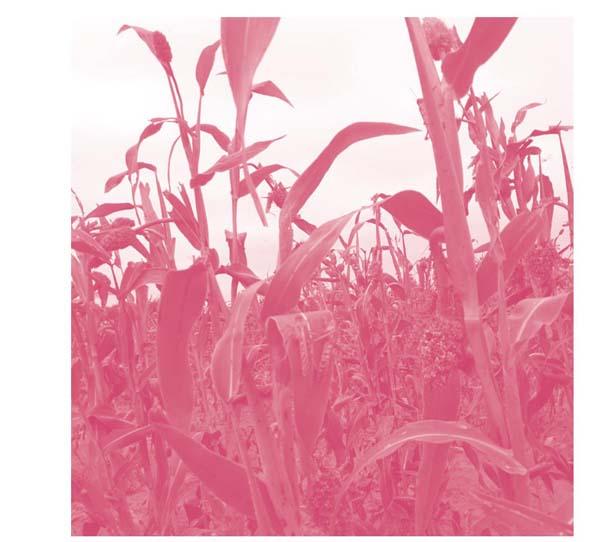Locust Swarms in Africa Are Worst in Decades 非洲遭受数十年来最严重蝗灾
2020-08-07本·柯蒂斯乔斯法特·卡西雷卡拉·安娜
本·柯蒂斯 乔斯法特·卡西雷 卡拉·安娜


The hum of millions of locusts on the move is broken by the screams of farmers and the clanging of pots and pans. But their noise-making does little to stop the voracious insects from feasting on their crops in this rural community.
The worst outbreak of desert locusts in Kenya in 70 years has seen hundreds of millions of the bugs swarm into the East African nation from Somalia and Ethiopia. Those two countries have not had an infestation like this in a quarter-century, destroying farmland and threatening an already vulnerable region with devastating hunger.
“Even cows are wondering what is happening,” said Ndunda Makanga, who spent hours Friday trying to chase the locusts from his farm. “Corn, sorghum, cowpeas, they have eaten everything.”
When rains arrive in March and bring new vegetation across much of the region, the numbers of the fast-breeding locusts could grow 500 times before drier weather in June curbs their spread, the United Nations says.
“We must act immediately,” said David Phiri of the U.N. Food and Agricultural Organization, as donors huddled in Kenyas capital, Nairobi, a three-hour drive away.
About $70 million is needed to step up aerial pesticide spraying, the only effective way to combat them, the U.N. says. That wont be easy, especially in Somalia, where parts of the country are in the grip of the al-Qaeda-linked al-Shabab extremist group.
The rose-colored locusts turn whole trees pink, clinging to branches like quivering ornaments before taking off in hungry, rustling clouds.
Astonished by the finger-length insects, children dash here and there, waving blankets or plucking at branches to shake the locusts free. One woman, Kanini Ndunda, batted at them with a shovel.
Even a small swarm of the insects can consume enough food for 35,000 people in a single day, said Jens Laerke of the U.N. humanitarian office in Geneva.
Farmers are afraid to let their cattle out for grazing, and their crops of millet, sorghum and maize are vulnerable, but there is little they can do.
About 70,000 hectares (172,973 acres) of land in Kenya are already infested.
“This one, ai! This is huge,” said Kipkoech Tale, a migratory pest control specialist with the agriculture ministry. “Im talking about over 20 swarms that we have sprayed. We still have more. And more are coming.”
A single swarm can contain up to 150 million locusts per square kilometer of farmland, regional authorities say.
One especially large swarm in northeastern Kenya measured 60 kilometers long by 40 kilometers wide (37 miles long by 25 miles wide).
Kenya needs more spraying equipment to supplement the four planes now flying, Tale said. Ethiopia also has four.
They also need a steady supply of pesticides, said Francis Kitoo, deputy director of agriculture in southeastern Kenyas Kitui county.
“The locals are really scared because they can consume everything,” Kitoo said. “Ive never seen such a big number.”
The locusts eat the fodder for animals, a crucial source of livelihood for families who now worry how they will pay for expenses like school fees, he said.
His own concern about the locusts?
“They will lay eggs and start another generation,” he said.
A changing climate has contributed to “exceptional” breeding conditions, said Nairobi-based climate scientist Abubakr Salih Babiker.
Migrating with the wind, the locusts can cover up to 150 kilometers (93 miles) in a single day. They look like tiny aircraft lazily crisscrossing the sky.
They are now heading toward Uganda and fragile South Sudan, where almost half the country faces hunger as it emerges from civil war. Uganda has not had such an outbreak since the 1960s and is already on alert.
The locusts also are moving steadily toward Ethiopias Rift Valley, the breadbasket for Africas second-most populous country, the U.N. says.
“The situation is very bad but farmers are fighting it in the traditional way,” said Buni Orissa, a resident of Ethiopias Sidama region. “The locusts love cabbage and beans. This may threaten the shaky food security in the region.”
Even before this outbreak, nearly 20 million people faced high levels of food insecurity across the East African region long challenged by periodic droughts and floods.
As exasperated farmers look for more help in fighting one of historys most persistent pests, the FAOs Locust Watch offers little consolation.
“Although giant nets, flamethrowers, lasers and huge vacuums have been proposed in the past, these are not in use for locust control,” the U.N. agency says. “People and birds often eat locusts but usually not enough to significantly reduce population levels over large areas.”
Still, it offered recipes. One suggested seasoning in Uganda is chopped onion and curry powder. Then fry.
數百万蝗虫飞过,嗡嗡作响——农民大声喊叫,哐哐敲打锅盆,搅乱了那片轰鸣。他们想制造噪音阻止贪吃的蝗虫吞噬这片农地庄稼,但收效甚微。
肯尼亚暴发了70年来最严重的沙漠蝗灾,数亿只蝗虫从索马里和埃塞俄比亚涌入这个东非国家。而那两个国家已有25年没有出现过这样的虫害:蝗虫毁坏了农田,让这个本已罹患饥荒的地区雪上加霜。
恩丹达·马坎加说:“就连牛都在疑惑到底发生了什么。玉米、高粱、豇豆,蝗虫吃光了一切。”周五,他花了好几个钟头想把自家田里的蝗虫赶走。
联合国称,随着3月雨季到来,该地区很多地方会长出新的植被,蝗虫将会迅速繁殖,6月前,数量可能会增长500倍。6月进入旱季,会抑制蝗灾蔓延。
当捐助机构齐聚肯尼亚首都内罗毕时,联合国粮农组织的戴维·菲里表示:“我们必须立即采取行动。”内罗毕距离重灾区有三小时的车程。
联合国称,唯一有效的战“蝗”之术是加快在空中喷洒杀虫剂,而这需要投入约7000万美元。这并不容易,尤其在索马里,因为该国部分地区处于与基地组织有关联的极端组织青年党的控制中。
玫瑰色的蝗蟲使整棵整棵的树变成粉红色,它们紧紧贴在树枝上,像微微颤动的装饰品,直到饥饿觅食时整群飞起,沙沙作响,如同移动的云朵。
看到这些手指长的蝗虫,孩子们都大惊。他们四处奔跑,挥舞毯子或摇晃树枝把蝗虫赶走。一个叫卡尼尼·恩丹达的女子用铲子拍打蝗虫。
联合国驻日内瓦人道主义事务协调办公室的延斯·拉尔克说,即使一小群蝗虫,一天也能吃掉3.5万人的口粮。
农民不敢出去放牛,种的小米、高粱和玉米等庄稼都经不起侵袭,但他们也无能为力。
在肯尼亚,约有7万公顷(172973英亩)的土地已经受到侵害。
“这一次,哎!这次蝗灾规模巨大。”农业部的迁徙害虫控制专家基普科埃奇·塔莱说,“我是说我们已经对20多个蝗虫群喷洒了农药,可仍有很多要处理。而且,还有更多正在涌来。”
地方当局称,一个蝗虫群在每平方公里农田里的蝗虫可能多达1.5亿只。
肯尼亚东北部有一个特别大的蝗虫群,长60公里(37英里),宽40公里(25英里)。
塔莱说,肯尼亚目前有4架飞机在执行灭蝗任务,需要补充更多的喷洒设备。埃塞俄比亚也有4架飞机参与灭蝗。
肯尼亚东南部的基图伊县农业局副局长弗朗西斯·基图说,他们还需要持续稳定的杀虫剂供应。
“当地人真的很害怕,因为蝗虫能吃光一切。”基图说,“我从未见过这么多的蝗虫。”
他说,蝗虫吃家畜饲料,而家畜是家家户户生计的重要来源,现在民众都在担心如何支付各种费用,包括孩子的学费。
关于蝗虫,他本人担忧什么呢?
他说:“它们会产卵,繁殖下一代。”
内罗毕的气候学家阿布巴克尔·萨利赫·巴比克尔说,不断变化的气候为蝗虫“异常迅速的”繁殖起到了推波助澜的作用。
蝗虫随风迁移,一天最多可以飞行150公里(93英里)。它们看上去像是一架架微型飞机,懒散地漫天飞舞。
现在,蝗虫正前往乌干达和脆弱的南苏丹——这个国家在内战后几乎一半人口面临着饥荒。乌干达自1960年代以来还未发生过此类灾害,但目前已处于戒备状态。
联合国称,蝗虫也正向埃塞俄比亚境内的东非大裂谷稳步挺进,那里是非洲第二人口大国的粮仓。
埃塞俄比亚锡达马地区的居民布尼·奥里萨说:“这里的情况非常糟糕,但农民们还在用传统方式对抗蝗虫。蝗虫喜欢吃卷心菜和豆科植物。这可能威胁到我们这里脆弱的粮食安全。”
东非地区长期以来备受周期性干旱和洪灾之苦,就在此次蝗灾暴发前,已有近2000万人面临严重的粮食安全问题。
蝗虫是有史以来最顽固的害虫之一。为抗击蝗虫,烦恼不已的农民要寻求更多帮助,但联合国粮农组织的“蝗虫观察”服务网站没能提供多少安慰。
联合国粮农组织称:“过去有人建议用巨型网、火焰喷射器、激光和巨型真空吸尘器,但这些都不适合用于蝗虫防控。人类和鸟类经常吃蝗虫,但这通常不足以大面积显著减少蝗虫数量。”
尽管如此,粮农组织还是提供了一些蝗虫食谱。在乌干达,有一种推荐吃法:用切碎的洋葱拌上咖喱粉调味,然后和蝗虫一起炒着吃。 □
(译者为“《英语世界》杯”翻译大赛获奖者)
